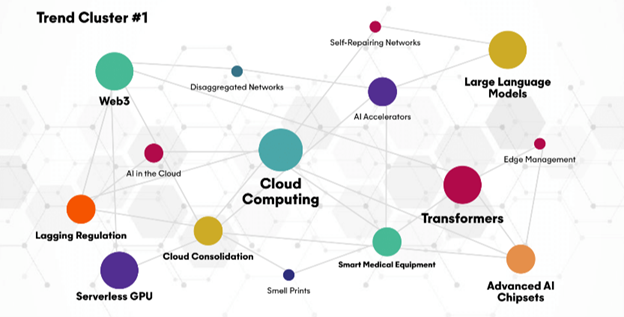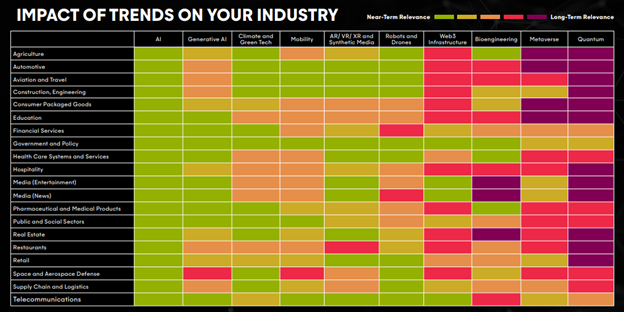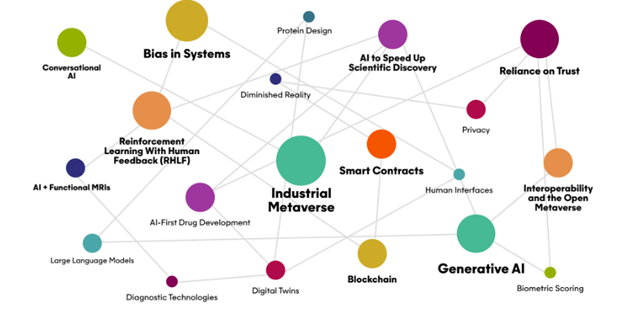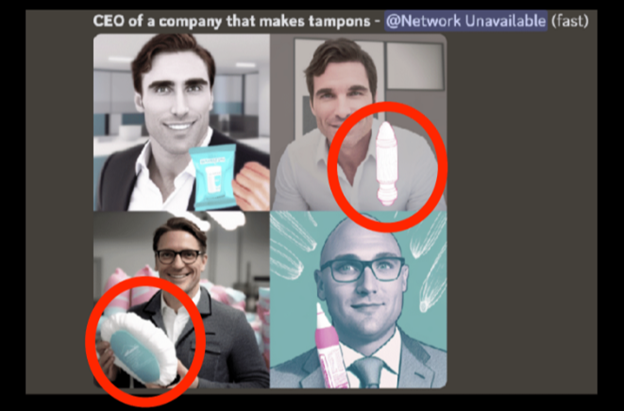The Evolution of the Internet Projected: SXSW 2023The Evolution of the Internet Projected: SXSW 2023
Futurist Amy Webb says the next iteration of the internet is here, thanks to a confluence of technological advances
.png?width=1280&auto=webp&quality=95&format=jpg&disable=upscale)
The internet as we know it is dead, thanks to a confluence of important tech developments, according to a well-respected futurist.
Advances in code – specifically generative AI − cloud and hardware have come together to reinvent what it means to interact online, said Amy Webb, CEO of Future Today Institute who uses a data-driven methodology for forecasting used in hundreds of companies globally.
Moreover, the rise of generalist AI models that can do several types of tasks, not just master one activity like winning chess games, is a crucial step toward achieving the Holy Grail of artificial general intelligence (AGI) where machines can solve a diversity of problems as well as humans.
“I have news for you,” she said. “We are now on that path.”
Webb shared two important convergent trends in tech at SXSW 2023 in Austin, Texas.
Convergent Trend #1: The Internet As We Know it is Gone.
The implication going forward is everything is information, she said.
In the 1990s, society understood the internet to be a global network of computers and electronic devices that facilitate the spread of digital information. "We were hanging out, we built this thing called the world wide web, which for the first time allowed people to browse the internet,” Webb said.
Then, from basic web pages, social sites such as MySpace emerged where people went online to connect and share their personal information. There also was iTunes where listeners not only accessed music but their behaviors were observed. EBay was a marketplace people used but it also collected data on what folks bought and sold.
“At that point, information about information, or metadata, became a valuable, monetizable research, not to mention all the bits about you − your personal information,” Webb said.
By the early 2000s, users needed a more powerful tool to find what they were looking for online. That was search and “it became clear there was a lot of money to be made there,” she said. There was Yahoo, AOL and Google. More metadata was created as the internet evolved.
“So now we have got new forms of content generated by all different types of people, and in some cases, just algorithms themselves,” Webb said. There was Reddit, Wikipedia and YouTube.
The Internet is Searching You
But now, “what if the internet is morphing into something different?” she asked. “Instead of us searching the internet, the internet is searching you.”
Webb said to understand what she meant, it is important to go back to 2017 to see the developments in code, cloud and hardware. Notably, Google’s researchers published this paper that introduced the idea of Transformers. These are a type of neural network that learns context in sequential data, which “fundamentally changes our relationship to information,” she said.
If the first version of search gave users blue hyperlinks, Webb said, the second version was ‘knowledge graphs’ that showed images and videos as well. Version three, the one that is just emerging, will be about the continuous transfer of information much like a human conversation.

As for computing, a big trend that developed were AI accelerators. These are specialized computer systems that can do tons of heavy computations to accelerate AI and machine learning processes. For example, ChatGPT used 10,000 Nvidia GPUs to train its model. “Most of us don’t have room in our apartments or company offices for 10,000 GPUs,” she said.
That means many companies access these accelerators in the cloud – or offsite data centers – and mainly those run by the world’s largest tech companies (hyperscalers such as Azure, Google Cloud, AWS) with the wherewithal to build this architecture. “Cloud infrastructure has become so complicated and so expensive that there are really only a few providers on the planet even capable of housing these new systems,” Webb said.
Right now, it is “very expensive” to run large language models like the one behind ChatGPT, she said. It costs 2 cents per query, or seven times more expensive than one basic Google search. But she believes prices will fall even as computing advances, as has been the trend in tech.
Data will continue to proliferate – and more kinds of data will be created. For example, she said Google is developing ‘smell prints,’ a model of sensor data that can predict the makeup of a molecule. One of its first projects is to figure out what molecules mosquitoes hate so they can generate a scent to repel them. This opens the door to everyone having a unique, personal smell. That means someone could go into an empty room and know you were there, Webb said. That is data.
The new internet will be one in which all types of data flows into AI systems through any source or situation in a phenomenon Webb is calling “AIsmosis,” an amalgamation of ‘AI’ and ‘osmosis.’

Convergent Trend #2: The Assistive Computing Era is Here.
The implication of this trend is “you will never think on your own again,” Webb said.
That is not necessarily a bad thing. Assistive tools are all around, for example there is paper for taking notes and calculators for doing math, among many others. “Before paper, it was very hard to record information. Think of the value that paper created. It allowed ideas to spread,” she said. Calculators facilitated math calculations. “We don’t even think about them as tools anymore.”
In the same way, generative AI will offer many helpful tools to humanity. For example, a company called Absci uses generative AI to create antibodies from scratch. Antibodies “are part of our immune system and they can be biologically programmed to bind to specific tissues to do things like fight cancer,” Webb said. The startup is testing three million unique AI-generated designs every week.
“There’s no way a team of humans could do that on their own,” she said.
These assistive tools enhance productivity. But instead of embracing them, they are banned at places like New York City schools, JPMorgan and even a prestigious machine learning conference, she said.

Bias and Tampons
To be sure, there are early fears about generative AI enabling students to cheat or enticing employees to input proprietary company information into these AI tools. Webb did point to a major shortcoming that must be corrected: Its ability to spout wrong information. Bias is another issue to watch out for; training data must reflect the diversity of society.
Webb said search has long had a bias problem. Seven years ago, she googled the word 'CEO' and got back images of males. The first woman to appear in search was CEO Barbie. This week, she asked text-to-image tool Midjourney to draw a CEO and received drawings of all men. Thinking that she might get more diversity at smaller companies, she asked Midjourney to draw the CEO of a mid-sized company and a startup. Webb still got males.
Finally, Webb asked for a drawing of a CEO of a tampon company. Surely, a woman CEO must appear this time. She still got images comprised of all men.

“Bias is irritating,” she said. “These AI tools don’t have intuition … and they can only reflect the data that they have been fed and housed within their associative memory. Soon, we are going to – like it or not – be relying on these systems for school, for work, for governing and that scares … me. Not because they do not work well, but because they actually work very well.”
For more, readers can access her full report here.
This article first appeared on IoT World Today's sister site AI Business.
Read more about:
SXSW 2023About the Author
You May Also Like
.png?width=100&auto=webp&quality=80&disable=upscale)
.png?width=400&auto=webp&quality=80&disable=upscale)
.jpg?width=700&auto=webp&quality=80&disable=upscale)
.jpg?width=700&auto=webp&quality=80&disable=upscale)

.jpg?width=300&auto=webp&quality=80&disable=upscale)


